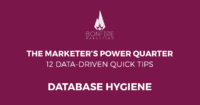Visualization is key in this week’s #MetricsMonday post. We’ll explore how using Google’s In-Page Analytics tool goes beyond displaying how people are clicking and engaging with your website. This reporting tool provides insight into overall UX and content consumption to improve your website as well as site pages.
How do I access Google In-Page Analytics
In-Page Analytics is a flexible reporting tool, working within the traditional Google Analytics dashboard and through a Google Chrome Extension.
To access In-Page Analytics through Google Analytics:
- Login to Google Analytics.
- Navigate to Reporting.
- Scroll down to Behavior.
- Under Behavior, click on In-Page Analytics.
This view allows you to access the In-Page Analytics.
NOTE: You may see an error message, such as below.
Don’t worry. As Digital Donut explains, “This isn’t actually a problem — if you don’t load in full view, your Web page is shown within the Google Analytics page and you will need to scroll up and down to access the whole page. Full View means you see the Web page live and as visitors would see it but with the analytics data superimposed and, as such, it is much easier to use.”
Click on “Load in Full View” and access In-Page analytics. This view provides a more expansive look without additional scrolling.
You can also view In-Page Analytics through Google Chrome’s Extension. This will allow you to see analytics without having to navigate to your Google Analytics dashboard.
This can be useful if you want to check In-Page Analytics on multiple sites you have access to via Google Analytics. Simply navigate to each site and ensure the extension is turned on in your browser.
How does In-Page Analytics work?
When viewing In-Page Analytics, you will see data through the visual layout of the page. To source this data, Google Analytics “infers the number of clicks on a page element from the number of times that page appears as the referrer to subsequent pages.”
This means that if a page receives 10 clicks from the homepage and the homepage has two links to that page, each link is given 10 clicks.
While this allows for greater insight, enhanced link attribution does a better job of providing clear, actionable data about which links are driving referrals.
What does In-Page Analytics provide insight on?
As we explain in a previous Metrics Monday post, In-Page Analytics “is a valuable tool that helps you visually assess how your visitors engage with your site’s pages.”
Specifically, In-Page Analytics allows you to see on-page data for clicks, goal value, time on page, and other core metrics. A useful feature is the ability to sort this data by color and filter.
Colors range from blue to red, with red receiving the highest clicks, goal value, or key metrics. Blue represents the lowest amount.
You can also filter by occurrence. For example, you filter to only see data with links that receive over 10 clicks.
Answer 3 key questions with In-Page Analytics
1. Is my layout accomplishing what I want it to?

Often, a layout of a website is completed through a committee process, involving the client, creatives, strategists, executives, and others. While collaboration is key, it can sometimes lead to a layout that doesn’t speak to who it is supposed to: the visitor.
Use In-Page Analytics to visualize which areas visitors are engaging with and which areas they are not. Perhaps you’ll find it is necessary to move a key CTA “above the fold” or remove a page from the navigation.
While certain information regarding pageviews can be accessed via Google Analytics, seeing this on page allows you to move from data to design.
2. Are they consuming the content I want them to?
In-Page Analytics will also show you which content is being consumed and can help to answer the why.
Testing this can be crucial, especially if looking for visual reasons why a certain post or a certain landing page is receiving more traffic or clicks than another.

On our homepage, you can see our most popular pages are the Team and Careers pages, located on the far right. Understanding both the importance of these pages and whether they should be moved in the navigation are the types of questions In-Page Analytics can help to address.
3. Can users find what they are looking for?
By viewing where users are clicking on your site, you can see whether certain elements of a page are buried. Is your most popular content front and center? If most people have difficulty finding your most popular content, move it front and center.
Practical Ecommerce offers a great example of a navigation bar with a high level of traffic going to a “More” dropdown. If users are asking for more without visiting other highlighted pages as often, it can signify a need to revise your navigation bar.
By answering these key questions, you can better tailor your website and its content. Google In-Page analytics is the perfect tool to bring together the data of your website with a visual dimension for deeper analysis.
Additional resources:
- How to Measure Engagement with Behavior Flow and In-Page Analytics: A guide to using both In-Page Analytics and Behavior Flow to ensure your content and UX are as strong as possible.
- Using Google’s In-page Analytics, for Link Performance: An insightful article into how Google In-Page Analytics can be used to gauge performance on your website content.
- About In-Page Analytics: A concise overview and tutorial on how to set up, navigate, and utilize this tool.
More Content
How to Create Personas With Google Analytics
Personas are critical for the success of your marketing efforts, digital or not. Strong personas are a reference for every department in your company or agency — from strategy to
The Marketer’s Power Quarter: Updating Lead Databases
This is the tenth in a 12-part series of quick-fix tips to improve your digital marketing results. Catch up on our last tip, and subscribe to our newsletter to get the
AI in Marketing: How to Get Started in 2018
One of the biggest buzzwords in marketing, and really across many industries, is artificial intelligence. For years, a majority of the public viewed AI as science fiction, but that’s starting







Leave A Comment